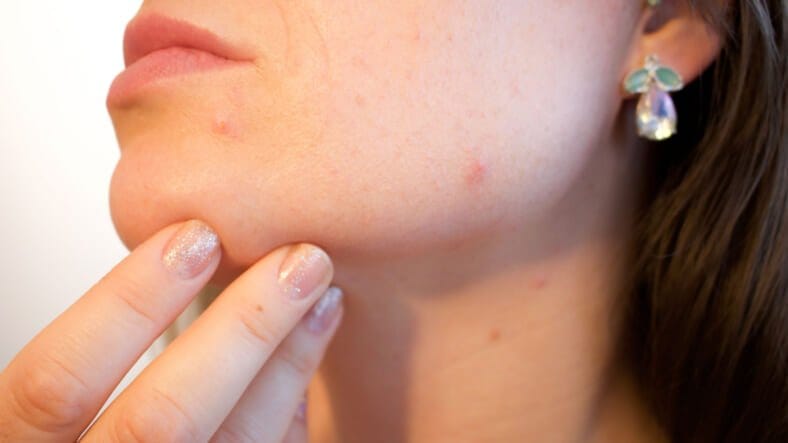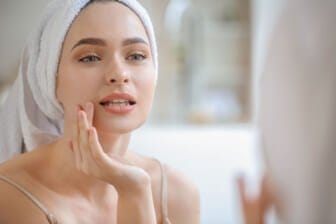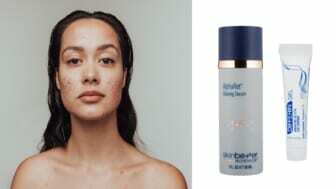
Acne is the most common skin condition, and according to the American Academy of Dermatology, it affects up to 50 million Americans annually. Still, despite its prevalence in society, there are many misconceptions about acne making rounds today, often leading to mistreatment, damaged skin, or increased emotional distress.
So we asked two top dermatologists to clear things up, starting with the idea that acne is something to be ashamed of (spoiler: it’s not!). Read on for 12 common acne myths debunked by derms.
1. Myth: People with acne practice poor hygiene
Acne is not caused by uncleanliness. “I think this is a very important point so that those struggling with acne know it’s not their fault,” says Hadley King, MD, a dermatologist in NYC and consulting doctor for AcneFree. The two main causes of acne are genetics and hormones, she explains. While some skincare habits, like not washing your face regularly or using products that clog pores, can contribute to mild acne, it’s usually not the cause of more severe cases, adds Ife Rodney, MD, a dermatologist and founding director of Eternal Dermatology located in Fulton, MD.

The Best Face Washes for Acne 2022
2. Myth: Only young people get acne
We often associate acne with teenagers. While it’s estimated that 85 percent of teens struggle with some type of acne, they aren’t the only ones who experience it. “Because each person’s individual experience with acne will be unique, it’s impossible to predict exactly what the course will be,” says Dr. King. The hormones and hormonal effects of puberty will shift as a person ages into adulthood, and for some, this will mean that acne will abate. For others it will mean that the acne will evolve into a pattern of adult acne.” Studies show that approximately 54 percent of adult women experience acne, and for some, it can persist into their 50s.
3. Myth: Acne is more common in lighter skin tones
According to the Journal of Clinical and Aesthetic Dermatology, acne is the most common dermatological diagnosis in non-Caucasian patients. “Although acne may look different in different skin tones, it occurs in all and risk does not correlate with color of the skin,” says Dr. King. For example, she explains that redness may not show up as much on darker skin tones, but POC often experience more discoloration when acne clears. This condition is known as post-inflammatory hyperpigmentation, and it affects over two-thirds of black women.
4. Myth: Acne-prone skin types shouldn’t use moisturizer
If you’re breaking out, you may be tempted to skip moisturizer, but doing so can make matters worse. When the skin lacks moisture, it produces more sebum to replenish the skin barrier. So keeping it balanced is key. “An ideal moisturizer contains three components: humectants to hydrate the skin, emollients to support the skin barrier, and occlusives to lock in the moisture,” explains Dr. King. “Those with oily and acne-prone skin still need these properties, particularly if they are using potentially drying topical anti-acne ingredients like salicylic acid, benzoyl peroxide, and retinoids.” She suggests looking for a moisturizer that is non-comedogenic, meaning it won’t clog pores or contribute to acne.
5. Myth: Acne products burn when they are working
No pain, no gain? “This is absolutely false,” says Dr. Rodney. “Burning or irritation means that the products are too harsh and may be damaging your skin.” While it’s true that some ingredients may cause some tingling upon contact with skin (think alpha hydroxy acids) and others may cause skin to become more sensitive with use (think retinol), your skincare should never make your face feel like it’s on fire. If a product is causing you pain, stop use and consult your dermatologist.
6. Myth: Popping zits will make them go away faster
“No! No! No! Picking and squeezing acne lesions increases risk for inflammation, infection, discoloration, and scarring, as well as prolongs healing time,” Dr. King emphasizes. If you are tempted to pick at pimples, consider using zit stickers to remind you to keep your hands off.
7. Myth: The more aggressive exfoliation, the better
There are definite benefits of exfoliation (smoother, brighter skin!) but scrubbing too much will cause more harm than good. “Over-exfoliating can cause inflammation and trauma of the skin, which can inflame your acne and lead to scarring, discoloration or dark spots,” says Dr. Rodney. “This may take many months to fade and may never completely improve.” She recommends gentle exfoliation, no more than three times a week.
8. Myth: Sun exposure is a healthy way to treat acne
Although sun exposure can down-regulate the immune system in the skin and therefore temporarily improve inflammatory acne, this is not a safe or effective solution, says Dr. King. Not to mention the side effects of this approach, which include post-inflammatory hyperpigmentation, premature skin aging, and increased risk of skin cancer. Repeat after me: Not worth it.
9. Myth: Eating chocolate causes acne
According to Dr. Rodney, some studies have shown a link between dairy products, foods with a high glycemic index (e.g. sugary, oily, and processed foods) and acne, while other studies have shown no connection at all. While diet affects many aspects of our lives, eating healthy is not enough to prevent or reverse acne, she says. If you do think eating any certain food is causing breakouts, remove that food from your diet and monitor your skin.
10. Myth: Rubbing alcohol kills acne
While we all love a good skincare hack, using rubbing alcohol to treat acne isn’t advised. “Alcohol is a common ingredient in many skincare products because it dries quickly,” explains Dr. Rodney. “When used in the right concentrations, it is safe for the skin. However, rubbing alcohol is much too concentrated and will cause drying and irritation, causing the skin to respond by overproducing oil.” Try a toner instead.
11. Myth: Toothpaste is an effective spot treatment for acne
This is another skincare hack derms say you should skip if you are serious about banishing a blemish. “Most toothpastes contain alcohol or menthol. Because these agents are drying to the skin, they can shrink smaller acne pimples,” says Dr. Rodney. “However, using a traditional over-the-counter acne medication containing either benzoyl peroxide or salicylic acid would be much more effective.”
12. Myth: For some people, acne is here to stay
Though everyone’s skin is different, almost all cases of acne can be cleared. If you’re not seeing results on your own with OTC products, a dermatologist can offer you a personalized treatment plan. For stubborn cases, they will often prescribe a combination of topical medications and oral antibiotics, as well as a suggested skincare regimen. Keep in mind, as effective as this approach can be, it does take some time (and consistency!) to work.



